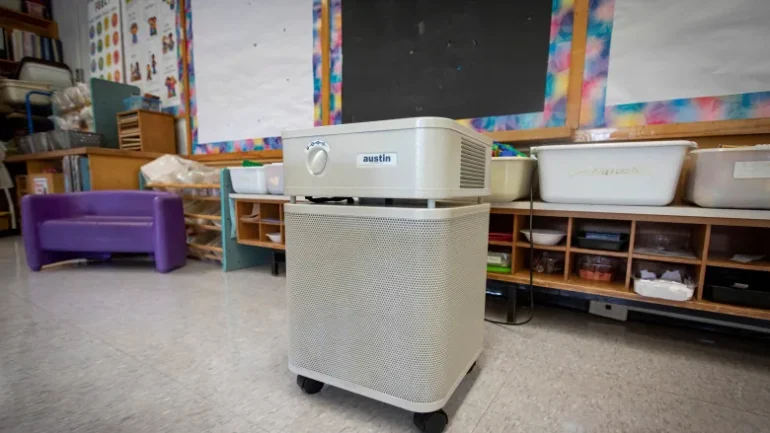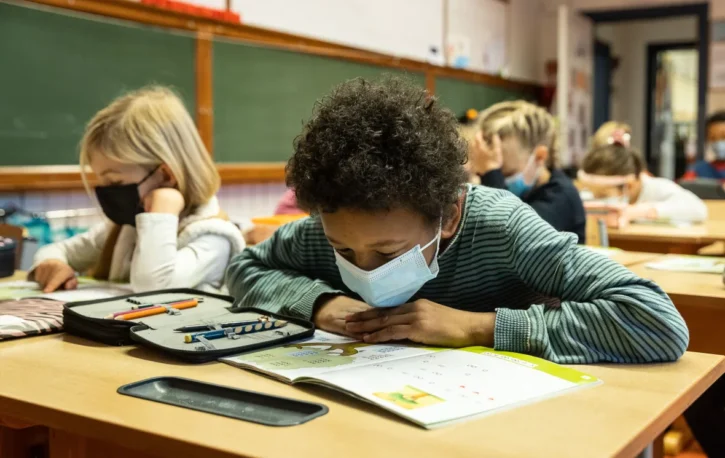- Your cart is empty
- Continue Shopping
Research on HEPA filters and COVID is slim, but some experts are optimistic

Air cleaners ‘a very effective means for supplementing the filtration within a classroom’: epidemiologist

Many students returning to in-person learning on Monday will have to get used to a new sound in the classroom: the buzz of a portable air cleaner.
Several provincial and territorial governments will reopen schools on Monday for the first time since before the December holidays.
The delay was, in part, to better protect teachers and students against the Omicron wave with better masks — and in Ontario, to deliver thousands of air cleaners with HEPA filters to classrooms. The latter move was lauded by some experts and questioned by others.
“Even after there are HEPA filters and different masks, there will still be children and adults who contract COVID-19 in the school setting,” said Dr. Jeffrey Pernica, a pediatrician and head of the division of infectious disease at McMaster University in Hamilton.
He told Cross Country Checkup thatschools should not have remained closed until HEPA systems could be secured. Online learning has a negative impact on the mental and physical health of many children, he added.
“We will never prevent that [transmission] entirely, just in the same way that we will still be having teachers, adult school staff and children acquiring COVID-19 outside of the school setting.”

There are questions about the efficacy of HEPA filters in reducing transmission of COVID-19, including disputed claims that they can do more harm than good. On its website, the Public Health Agency of Canada states that the effectiveness of air filtration for reducing COVID-19 transmission “hasn’t yet been demonstrated.”
Jeff Siegel, a University of Toronto civil engineering professor who studies air filtration and air flow, acknowledges that scientific data on filtering the novel coronavirus from air is still limited. Based on what’s known about airborne transmission of SARS-CoV-2, however, they will help, he said.
“So the best evidence is, admittedly, inferred evidence saying that we know that some of the transmission risk is coming from these respiratory particles, so a filter that removes those respiratory particles thereby reduces the risk,” Siegel said.
Filters must fit classroom size
Siegel told Checkup that he believes air purifiers should have been added to classrooms back in 2020, and that air quality in schools more broadly is too often overlooked. Recent HEPA filter additions are “better than nothing,” he said.
Krystal Pollitt, an assistant professor of epidemiology at Yale University who studies airborne transmission of the novel coronavirus, agreed that air cleaners can provide a tangible benefit.
“HEPA filters, from commercial units to DIY air cleaners, are definitely very useful in the classroom environment,” she told Checkup. “They’re all a very effective means for supplementing the filtration within a classroom.”
WATCH | Concern about school safety as some students return amid Omicron’s spread:
Students in B.C. and Alberta return to school this week as the Omicron variant rages, but several other provinces have pushed back a return to the classroom. Now, experts and parents are torn over what’s worse for kids — exposing them to more isolation or more infection. 4:23
However, the effectiveness of HEPA filters depends on a variety of factors, including placement in the classroom, the size of the air cleaner relative to the room size and temperature, as well as external factors such as central ventilation systems or open windows.
Air cleaners work by drawing air through a filter — think of it like a sink strainer that prevents food from going down the drain — using a fan. An appropriately-sized system should be able to filter all the air in a room multiple times per hour, a factor determined by a device’s clean air delivery rate, or CADR.
A small filter in a large classroom, then, won’t have much impact on the transmission of COVID-19, indicating a need for what Siegel calls “building-aware epidemiology.”
“Part of the problem with the [lack of] evidence is that people like me, who know something about buildings and indoor air quality, have not kind of been at the table very much when the epidemiology is being discussed,” he said.
Siegel note that a system which replaces the air in a room six times per hour is ideal. He is advocating for two filter systems per classroom.

Tips for teachers, staff using HEPA filters
Adding air cleaners to a classroom doesn’t mean that other infection prevention measures become obsolete. In fact, Siegel says masking and vaccination should be priority even when using HEPA filters.
But they appear to be particularly useful when masking isn’t an option.
“In short of being outdoors or having all the windows open, which we know is not going to be possible for the upcoming weeks, then having other ways of offering more filtration … that’s what these HEPA filters can offer,” said Pollitt.
For teachers and school staff using air cleaners for the first time, Siegel says a couple simple tips can improve their efficacy in the classroom.
The devices should be placed as close to the centre of a room as possible, he says. One option is to place it between the teacher near the front of the class and students toward the back.
“That helps cover transmission in both directions, And it also [puts] it in the sphere of influence of the teacher to control it,” he said.
If noise from the machine is a consideration — and a good air cleaner is loud, Siegel said — he recommends keeping the fan set to low or medium during quiet periods, and turning it up to high at lunch time when masks are removed.
“That’s the kind of instruction I wish we were giving to teachers,” said Siegel.









Cool. Your blog looks great, and I’m glad i’ve found something here worth adding to my favorites.